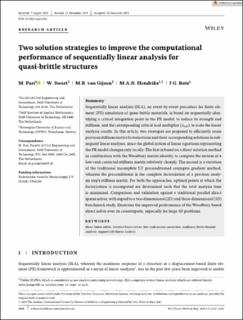| dc.contributor.author | Pari, Manimaran | |
| dc.contributor.author | Swart, W | |
| dc.contributor.author | van Gijzen, Martin Bastiaan | |
| dc.contributor.author | Hendriks, Max | |
| dc.contributor.author | Rots, Jan G | |
| dc.date.accessioned | 2021-04-08T08:50:57Z | |
| dc.date.available | 2021-04-08T08:50:57Z | |
| dc.date.created | 2020-04-28T17:49:12Z | |
| dc.date.issued | 2020 | |
| dc.identifier.citation | International Journal for Numerical Methods in Engineering. 2020, 121 (10), 2128-2146. | en_US |
| dc.identifier.issn | 0029-5981 | |
| dc.identifier.uri | https://hdl.handle.net/11250/2736783 | |
| dc.description.abstract | Sequentially linear analysis (SLA), an event‐by‐event procedure for finite element (FE) simulation of quasi‐brittle materials, is based on sequentially identifying a critical integration point in the FE model, to reduce its strength and stiffness, and the corresponding critical load multiplier (λcrit), to scale the linear analysis results. In this article, two strategies are proposed to efficiently reuse previous stiffness matrix factorisations and their corresponding solutions in subsequent linear analyses, since the global system of linear equations representing the FE model changes only locally. The first is based on a direct solution method in combination with the Woodbury matrix identity, to compute the inverse of a low‐rank corrected stiffness matrix relatively cheaply. The second is a variation of the traditional incomplete LU preconditioned conjugate gradient method, wherein the preconditioner is the complete factorisation of a previous analysis step's stiffness matrix. For both the approaches, optimal points at which the factorisation is recomputed are determined such that the total analysis time is minimised. Comparison and validation against a traditional parallel direct sparse solver, with regard to a two‐dimensional (2D) and three‐dimensional (3D) benchmark study, illustrates the improved performance of the Woodbury‐based direct solver over its counterparts, especially for large 3D problems. | en_US |
| dc.language.iso | eng | en_US |
| dc.publisher | Wiley | en_US |
| dc.rights | Navngivelse 4.0 Internasjonal | * |
| dc.rights.uri | http://creativecommons.org/licenses/by/4.0/deed.no | * |
| dc.title | Two solution strategies to improve the computational performance of sequentially linear analysis for quasi‐brittle structures | en_US |
| dc.type | Peer reviewed | en_US |
| dc.type | Journal article | en_US |
| dc.description.version | publishedVersion | en_US |
| dc.source.pagenumber | 2128-2146 | en_US |
| dc.source.volume | 121 | en_US |
| dc.source.journal | International Journal for Numerical Methods in Engineering | en_US |
| dc.source.issue | 10 | en_US |
| dc.identifier.doi | 10.1002/nme.6302 | |
| dc.identifier.cristin | 1808520 | |
| cristin.ispublished | true | |
| cristin.fulltext | preprint | |
| cristin.qualitycode | 2 | |

